Methods for Watering Seedlings in Arid Zones
Abstract
1. Introduction
2. General Features and Discharge Equations of Nonconventional Irrigation Systems
3. Classification and Description of the Different NCISs
3.1. Direct Deep Irrigation
3.1.1. Microirrigation by Deep Pipes
3.1.2. Irrigation with Horizontal Perforated Pipes
3.2. Irrigation through Porous Walls
3.2.1. Irrigation with Buried Clay Pots
3.2.2. Recycled PET Bottles with Fiber Filters
3.3. Wick Irrigation
3.4. Irrigation with Solar Distillers
4. Comparison of Irrigation Systems
- ○
- Very low cost: Ca < EUR 0.50;
- ○
- Low cost: 0.50 ≤ Ca < EUR 1.00;
- ○
- Medium cost: 1.00 ≤ Ca < EUR 2.00;
- ○
- High cost: 2.00 ≤ Ca < EUR 3.50;
- ○
- Very high cost: Ca ≥ EUR 3.5.
- ○
- Very low/low efficiency: when E and DP are not controlled (Ea < 0.60);
- ○
- Medium efficiency: one of these two variables is controlled;
- ○
- High efficiency: both variables are controlled;
- ○
- Very high efficiency: E and DP are avoided (Ea ≥ 0.95).
- ○
- Low maintenance: Sporadic supervision, very infrequent repairs;
- ○
- Medium maintenance: Supervision recommended at every irrigation event, infrequent repairs;
- ○
- High maintenance: Supervision at every irrigation event, frequent need for adjustments or repairs.
5. Conclusions
Author Contributions
Funding
Institutional Review Board Statement
Informed Consent Statement
Data Availability Statement
Conflicts of Interest
Appendix A1. List of Main Symbols
| Symbol | Meaning |
| A | Infiltration surface; surface area of an oozer; cross section of a wick or felt mat (m2) |
| AWC | Available water capacity; water retention capacity (mm·m−1) |
| c | Discharge coefficients (unitless) |
| Ca | Cost of the acquisition and installation of the micro irrigation system (EUR·unit–1) |
| CAP | Pit capacity (L) |
| D | Irrigation dose (L) |
| DP | Deep percolation (mm·day–1) |
| e | Thickness of the oozer’s walls; wick’s length fully saturated with water (m) |
| E | Evaporation; soil evaporation (mm·day–1) |
| Ea | Water application efficiency (unitless) |
| E1 | Evaporation from the inner bottle of the Konkom (L·day–1) |
| E2 | Evaporation off the soil inside the Konkom (L·day–1) |
| ET0 | Potential or reference evapotranspiration (mm·day–1) |
| Fn(…) | Function sign (function number n) (unitless) |
| f | Infiltration capacity (mm·h–1) |
| h | Working pressure head at the emitter (m) |
| I | Slope of the wick (m/m; unitless) |
| k | Emitter coefficient (L·h–1·m–x) |
| ks | Saturated hydraulic conductivity; permeability (mm·h–1) |
| kso | Saturated hydraulic conductivity of the oozer (mm·h–1) |
| kss | Saturated hydraulic conductivity of the soil (mm·h–1) |
| ksw | Saturated hydraulic conductivity of the wick (mm·h–1)Note: Logical inequations to be satisfied: |
| n | Numerical subscript of the functions (n = 1, 2, 3,…) (unitless) |
| Op | Optical properties of the Konkom’s outer bottle (light reflection, transmission, and absorption) (W·m–2) |
| P1 | Precipitation by dripping from the ceiling of the Konkom (L·day–1) |
| P2 | Precipitation by dripping from the walls of the Konkom’s outer bottle (L·day–1) |
| P3 | Dew on the soil surface of the Konkom (L·day–1) |
| P4 | Occult precipitations inside the soil (L·day–1) |
| q | Emitter flow rate (L·h–1 or L·day–1) |
| q1 | Flow rate absorbed by the roots (L·day–1) |
| q2 | Flow rate lost by evaporation (L·day–1) |
| q3 | Flow rate lost by percolation (L·day–1) |
| RS | Solar radiation (irradiance) received by the Konkom (W·m–2) |
| ST | Soil texture (mm) |
| T | Air temperature (K) |
| Va | Volume of water delivered to the soil by the irrigation system (L) |
| Vb | Volume of water available for use by the seedlings ( L) |
| x | Emitter exponent (unitless) |
| X | Characteristic length of the Konkom (m) |
| Z | Height difference between the porous capsule and the water intake (m) |
| ψ | Target or characteristic water potential (m) |
References
- Bainbridge, D.A.; Fidelibus, M.; MacAller, R. Techniques for Plant Establishment in Arid Ecosystems. Ecol. Restor. 1995, 13, 190–197. [Google Scholar] [CrossRef]
- Matorel García, M. Programa Piloto De Reforestación Extensiva. Bosques Para El Futuro. Master Thesis, University of Piura, Piura, Peru, 1996. [Google Scholar]
- Cerrillo, R.M.N.; Suárez, A.M. Las marras producidas por ausencia de cuidados culturales. Cuad. De La Soc. Española De Cienc. For. 1997, 4, 43–57. [Google Scholar]
- Grantz, D.A.; Vaughn, D.L.; Farber, R.J.; Kim, B.; Ashbaugh, L.; VanCuren, T.; Campbell, R.; Bainbridge, D.; Zink, T. Transplanting Native Plants to Revegetate Abandoned Farmland in the Western Mojave Desert. J. Environ. Qual. 1998, 27, 960–967. [Google Scholar] [CrossRef]
- Bean, T.M.; Smith, S.E.; Karpiscak, M.M. Intensive revegetation in Arizona’s Hot Desert: The Advantages of Container Stock. Nativ. Plants J. 2004, 5, 173–180. [Google Scholar] [CrossRef]
- Squeo, F.A.; Jiménez, M.; Albán, L.; Reyes, J.; Gutiérrez, J.; Holmgren, M. Tree establishment along an ENSO experimental gradient in the Atacama desert. J. Veg. Sci. 2007, 18, 195–202. [Google Scholar] [CrossRef]
- Del Río San José, J.; Reque Kilchenmann, J.; Martínez de Azagra Paredes, A. To replant or to irrigate: A silvicultural decision model for afforestation projects. For. Policy Econ. 2018, 93, 18–29. [Google Scholar] [CrossRef]
- Martínez de Azagra Paredes, A. Diseño De Sistemas De Recolección De Agua Para La Repoblación Forestal; Mundi-Prensa: Madrid, Spain, 1996. [Google Scholar]
- Prinz, D. Water harvesting for afforestation in dry areas. In Proceedings of the 10th International Conference on Rainwater Catchment Systems, Mannheim, Germany, 10–14 September 2001; pp. 195–198. [Google Scholar]
- Navarro Hevia, J.; Martínez de Azagra Paredes, A.; Mongil Manso, J. Hidrología de conservación de aguas. Captación de precipitaciones horizontales y escorrentías en zonas secas. Universidad de Valladolid: Valladolid, Spain, 2009. [Google Scholar]
- Bainbridge, D.A. A Guide for Desert and Dryland Restoration: New Hope for Arid Lands; Island Press: Washington, DC, USA, 2007. [Google Scholar]
- Oliet, J.A.; Jacobs, D.F. Microclimatic conditions and plant morpho-physiological development within a tree shelter environment during establishment of Quercus ilex seedlings. Agric. For. Meteorol. 2007, 144, 58–72. [Google Scholar] [CrossRef]
- Liu, X.; Fan, Y.; Long, J.; Wei, R.; Kjelgren, R.; Gong, C.; Zhao, J. Effects of soil water and nitrogen availability on photosynthesis and water use efficiency of Robinia pseudoacacia seedlings. J. Environ. Sci. 2013, 25, 585–595. [Google Scholar] [CrossRef]
- Alrababah, M.A.; Bani-Hani, M.G.; Alhamad, M.N.; Bataineh, M.M. Boosting seedling survival and growth under semi-arid Mediterranean conditions: Selecting appropriate species under rainfed and wastewater irrigation. J. Arid. Environ. 2008, 72, 1606–1612. [Google Scholar] [CrossRef]
- Al-Hawija, B.N.; Lachmuth, S.; Welk, E.; Hensen, I. Performance of seedlings from natural and afforested populations ofCupressus sempervirensunder different temperature and moisture regimes. Plant Species Biol. 2014, 30, 257–271. [Google Scholar] [CrossRef]
- Varsamis, G.; Papageorgiou, A.C.; Merou, T.; Takos, I.; Malesios, C.; Manolis, A.; Tsiripidis, I.; Gailing, O. Adaptive Diversity of Beech Seedlings Under Climate Change Scenarios. Front. Plant Sci. 2019, 9, 1918. [Google Scholar] [CrossRef] [PubMed]
- Gaoabc, Y.; Qiuad, G.; Shimizua, H.; Tobea, K.; Sunc, B.; Wangb, J. A 10-Year Study on Techniques for Vegetation Restoration in a Desertified Salt Lake Area. J. Arid Environ. 2002, 52, 483–497. [Google Scholar] [CrossRef]
- Rey Benayas, J. Growth and survival in Quercus ilex L. seedlings after irrigation and artificial shading on Mediterranean set-aside agricultural land. Ann. Des Sci. For. 1998, 55, 801–807. [Google Scholar] [CrossRef]
- Martínez de Azagra Paredes, A.; Del Río San José, J. Los riegos de apoyo y de socorro en repoblaciones forestales. Foresta 2012, 53, 32–44. [Google Scholar]
- Sheng-Han, S. On “Fan Shêng-chih Shu”: An Agriculturist Book of China written by Fan Shêng-chih Shu in the First Century BC; Science Book: Peking, China, 1974; pp. 36–37. [Google Scholar]
- Estrela, M.J.; Valiente, J.A.; Corell, D.; Fuentes, D.; Valdecantos, A. Prospective use of collected fog water in the restoration of degraded burned areas under dry Mediterranean conditions. Agric. For. Meteorol. 2009, 149, 1896–1906. [Google Scholar] [CrossRef]
- Valiente, J.A.; Estrela, M.J.; Corell, D.; Fuentes, D.; Valdecantos, A.; Baeza, M.J. Fog water collection and reforestation at a mountain location in a western Mediterranean basin region: Air-mass origins and synoptic analysis. Erdkunde 2011, 65, 277–290. [Google Scholar] [CrossRef]
- Keller, J.; Karmeli, D. Trickle Irrigation Design Parameters. Trans. ASAE 1974, 17, 0678–0684. [Google Scholar] [CrossRef]
- Morbidelli, R.; Corradini, C.; Saltalippi, C.; Flammini, A.; Dari, J.; Govindaraju, R.S. Rainfall Infiltration Modeling: A Review. Water 2018, 10, 1873. [Google Scholar] [CrossRef]
- Martínez de Azagra Paredes, A.; Del Río San José, J. Pitcher Irrigation: Some Theoretical and Practical Aspects. Irrig. Drain. 2019, 68, 542–550. [Google Scholar] [CrossRef]
- Martínez de Azagra Paredes, A.; Gómez Ramos, A. Hacia un agua justa; Universidad de Valladolid: Valladolid, Spain, 2017. [Google Scholar]
- Allué Andrade, J.L.; Navarro Garnica, M. Afforestation in Arid Zones; Kaul, R.N., Ed.; Dr. W. Junk N. V.: The Hague, The Netherlands, 1970; pp. 21–36. [Google Scholar]
- Bainbridge, D.A. Alternative Irrigation Systems for Arid Land Restoration. Ecol. Restor. 2002, 20, 23–30. [Google Scholar] [CrossRef]
- Sánchez Sánchez, J.; Ortega Oller, R.; Hervás Muñoz, M.; Padilla Ruiz, F.M.; Pugnaire de Idaola, F.I. El microrriego, una técnica de restauración de la cubierta vegetal para ambientes semiáridos. Cuad. De La Soc. Española De Cienc. Forestales. 2004, 17, 109–112. [Google Scholar]
- Martínez, J.; Reca, J. Water Use Efficiency of Surface Drip Irrigation versus an Alternative Subsurface Drip Irrigation Method. J. Irrig. Drain. Eng. 2014, 140, 04014030. [Google Scholar] [CrossRef]
- Bainbridge, D.A. Deep pipe irrigation. Overstory 2006, 175, 1–8. Available online: http://www.agroforestry.net/pubs/Deep%20pipe%20irrigation.pdf (accessed on 10 June 2021).
- Chahbani, B. The “Buried Stones Pocket”: A New Irrigation Technique for Tree Plantations in Arid Zones. In Water Saving Techniques for Plant Growth; Verplancke, H.J.W., De Strooper, E.B.A., De Boodt, M.F.L., Eds.; Kluwer Academic Publishers: Dordrecht, Netherlands, 1992; pp. 213–222. [Google Scholar]
- Chahbani, B. Innovations techniques pour l’optimisation de la collecte, de la conservation et de l’utilisation de l’eau pour un développement durable de l’agriculture pluviale dans les régions arides. In Mediterranean Rainfed Agriculture: Strategies for Sustainability; Cantero-Martínez, C., Gabiña, D., Eds.; CIHEAM.: Zaragoza, Aragon, Spain, 2004; pp. 73–78. [Google Scholar]
- Chahbani, B. The Buried Diffuser. 2012. Available online: http://www.chahtech.com/ (accessed on 16 June 2021).
- Gasc, J. La lutte contre la désertification. Mondes Et Cult. 2002, 62, 313–320. [Google Scholar]
- Mathieu, C. Une méthode d’irrigation par semi-conduites verticales adaptée aux zones sahéliennes. Résultats techniques et prospective de l’organisation des filières. Tropicultura 2006, 24, 120–123. [Google Scholar]
- Bainbridge, D.A. Gardening with Less Water; Storey Publishing: North Adams, MA, USA, 2015. [Google Scholar]
- Abu-Zreig, M.M.; Abe, Y.; Isoda, H. The auto-regulative capability of pitcher irrigation system. Agric. Water Manag. 2006, 85, 272–278. [Google Scholar] [CrossRef]
- Vasudevan, P.; Thapliyal, A.; Tandon, M.; Dastidar, M.G.; Sen, P.K. Factors controlling water delivery by pitcher irrigation. Irrig. Drain. 2014, 63, 71–79. [Google Scholar] [CrossRef]
- UNEP. Chapters 4.2 and 5.7 (about porous capsules). In Sourcebook of alternative technologies for freshwater augmentation in Latin America and the Caribbean; UNEP/OAS: Osaka, Japan, 1998; Available online: http://www.greenstone.org/. (accessed on 7 September 2021).
- Bainbridge, D.A. Buried clay pot irrigation: A little known but very efficient traditional method of irrigation. Agric. Water Manag. 2001, 48, 79–88. [Google Scholar] [CrossRef]
- Tilló Torres, J. Riego por exudación. In Proceedings of the International Congress “ApliMatec 06” (Aplicaciones Técnicas de los Materiales Textiles), AITEX, Valencia, Spain, 2006. [Google Scholar]
- Abu-Zreig, M.M.; Atoum, M.F. Hydraulic characteristics and seepage modelling of clay pitchers produced in Jordan. Can. Biosyst. Eng. 2004, 46, 15–20. [Google Scholar]
- Qiaosheng, S.; Zuoxin, L.; Zhenying, W.; Haijun, L. Simulation of the soil wetting shape under porous pipe sub-irrigation using dimensional analysis. Irrig. Drain. 2007, 56, 389–398. [Google Scholar] [CrossRef]
- Siyal, A.; Skaggs, T. Measured and simulated soil wetting patterns under porous clay pipe sub-surface irrigation. Agric. Water Manag. 2009, 96, 893–904. [Google Scholar] [CrossRef]
- Siyal, A.A.; van Genuchten, M.T.; Skaggs, T.H. Performance of Pitcher Irrigation System. Soil Sci. 2009, 174, 312–320. [Google Scholar] [CrossRef]
- Setiawan, B.I.; Hermanto, M.B.; Pakpahan, A. Utilization of sidoarjo mud to develop pitcher for irrigation. In International Symposium on Agricultural Engineering: Toward Sustainable Agriculture in Asia; Institut Pertanian: Bogor, Indonesia, 2009. [Google Scholar]
- Memon, A.H.; Soomro, A.G.; Gadehi, M.A. Water use efficiency and saving through pitcher and polyethylene bag over furrow irrigation. Pak. J. Agric. Agric. Eng. Vet. Sci. 2010, 26, 16–29. [Google Scholar]
- Gopinath, K.; Veeravalli, S.V. Auto-regulative capability of pot/pitcher irrigation. J. Sci. Ind. Res. India. 2011, 70, 656–663. [Google Scholar]
- Vasudevan, P.; Thapliyal, A.; Sen, P.K.; Dastidar, M.G.; Davies, P. Buried clay pot irrigation for efficient and controlled water delivery. J. Sci. Ind. Res. 2011, 70, 645–652. [Google Scholar]
- Abu-Zreig, M.; Abo-Izreik, A.; Elbasit, M.A.M.A. Water Seepage Rate from Clay Emitters. In Proceedings of the 2012 Dallas, TX, USA, 29 July–1 August 2012; American Society of Agricultural and Biological Engineers (ASABE): St. Joseph, MI, USA, 2012; p. 1. [Google Scholar]
- Serrada Hierro, R.; Navarro Cerrillo, R.M.; Pemán García, J. La calidad de las repoblaciones forestales: Una aproximación desde la selvicultura y la ecofisiología. Investigación Agraria: Sist. Y Recur. For. 2005, 14, 462–481. [Google Scholar]
- Sheikh, M.T.; Shah, B.H. Establishment of vegetation with pitcher irrigation. Pak. J. For. 1983, 33, 75–81. [Google Scholar]
- Ortega Sastriques, F.; Forbes López, T.; De la Rosa, S. Uso de potes porosos en la repoblación forestal, en suelos de zonas secas. Cienc. De La Agric. 1986, 27, 159–160. [Google Scholar]
- Jethwa, A.P. Notes on afforestation of arid lands of Kachchh district in Gujarat state. In Afforestation of Arid Lands; Dwivedi, A.P., Gupta, G.N., Eds.; Scientific Publishers: Jodhpur, India, 1993; pp. 29–32. [Google Scholar]
- Ghaibeh, A.R. Case Study 10, Water Conservation Technology (Ceramics). In Sourcebook of Alternative Technologies for Freshwater Augmentation in West Asia; 2011; Available online: http://www.unep.or.jp/ietc/Publications/TechPublications/TechPub-8f/C/Ceramics.asp (accessed on 11 September 2021).
- Mondal, R.C. Farming with pitcher: A technique of water conservation. World Crops 1974, 26, 91–97. [Google Scholar]
- Olguín Palacios, C. Riego por succión. Descripción del método y avances en la investigación. In Memorias del 1er Seminario Nacional de Riego por Goteo Tomo II; SARH: Hermosillo, Mexico, 6 October 1975; pp. 165–181. [Google Scholar]
- Olguín Palacios, C. Observaciones Sobre El Efecto De Riego Por Succión En El Rendimiento Y Desarrollo De Maíz (Variedad H-507) En El Distrito De Riego No. 41; Río Yaqui. Sonora. Memorándum Técnico: SARH, Mexico, 1977. Available online: https://www.researchgate.net/publication/259647395_OBSERVACIONES_SOBRE_EL_EFECTO_DE_RIEGO_POR_SUCCION_EN_EL_RENDIMIENTO_Y_DESARROLLO_DE_MAIZ_Variedad_H-507EN_EL_DISTRITO_DE_RIEGO_No_41_RIO_YAQUI_SONORA_MEXICO_1977 (accessed on 15 February 2022).
- Stein, T.M. Grundlagen und Technik der Gefäßbewässerung. Z. Für Bewässerungswirtschaft 1994, 29, 62–94. [Google Scholar]
- Stein, T.M. Hydraulische Leitfähigkeit von Gefäßmaterialien zur Gefäßbewässerung. Erste Versuchsergebnisse. Z. Für Bewässerungswirtschaft 1995, 30, 72–93. [Google Scholar]
- Stein, T.M. Möglichkeiten der Veränderung der hydraulischen Leitfähigkeiten von Gefäßbewässerungsmaterialien. Z. Für Bewässerungswirtschaft J. Appl. Irrig. Sci. 1996, 31, 165–181. [Google Scholar]
- Stein, T.M. Der Einfluß der Verdunstung, der hydraulischen Leitfähigkeit, der Wanddicke und der Oberfläche auf die Per-kolationsrate von Gefäßen zur Gefäßbewässerung. Z. Für Bewässerungswirtschaft J. Appl. Irrig. Sci. 1997, 32, 65–84. [Google Scholar]
- Stein, T.M. Der Einfluß der Kultur und anderer Faktoren auf die Perkolationsrate von Gefäßen zur Gefäßbewässerung. Z. Für Bewässerungswirtschaft J. Appl. Irrig. Sci. 1997, 32, 207–234. [Google Scholar]
- Stein, T.M. Erarbeitung und Überprüfung von Entwurfskriterien für Gefäßbewässerungsanlagen. Der Trop. (J. Agric. Trop. Subtrop.) 1998, 66, 1–175. [Google Scholar]
- Silva, A.D.S.; Magalhães, A.D.; Santos, E.D.; Morgado, L.B. Irrigação por potes de barro: I. Descrição do método e testes pre-liminares. In Boletim de Pesquisa, Empresa Brasileira de Pesquisa Agropecuaria y Centro de Pesquisa Agropecuaria do Trópico Semi-Arido; EMBRAPA-CPATSA: Petrolina, Brazil, 1982. [Google Scholar]
- Ashrafi, S.; Das Gupta, A.; Babel, M.S.; Izumi, N.; Loof, R. Simulation of infiltration from porous clay pipe in subsurface irrigation. Hydrol. Sci. J. 2002, 47, 253–268. [Google Scholar] [CrossRef][Green Version]
- Igbadun, H.E.; Barnabas, J. Hydraulic characteristics of porous clay pipes for subsurface irrigation. Pac. J. Technol. 2013, 14, 40–47. [Google Scholar]
- Matorel García, M. Riego en el desierto. Reservorios de exudación subterránea. Rev. Agronoticias 1998, 223, 34. [Google Scholar]
- Matorel García, M. Método para reforestar en ausencia de lluvias. Microrreservorios de exudación subterránea. Boletín Nº 23 de DarwinNotas. 2006. Available online: http://www.darwinnet.org/docs/microreservorios.pdf (accessed on 21 June 2021).
- Ortmann, G. Urlaubssichere Bewässerung für Pflanzen; Paul Parey: Hamburg, Germany, 1991. [Google Scholar]
- Kuntz, L.B. Wick Irrigation Systems for Subsistence Farming; Bachelor of Science; Massachusetts Institute of Technology: Cambridge, MA, USA, 2013. [Google Scholar]
- Wesonga, J.M.; Wainaina, C.; Ombwara, F.K.; Masinde, P.W.; Home, P.K. Wick material media for capillary wick based irrigation system in Kenya. Int. J. Sci. Res. 2014, 3, 613–617. [Google Scholar]
- Bainbridge, D.A. Beyond Drip Irrigation – Hyper-efficient Irrigation. In Proceedings of the 2006 ASAE Annual Meeting, Portland, OR, USA, 9–12 July 2006; Paper number 062073; American Society of Agricultural and Biological Engineers (ASABE): St. Joseph, MI, USA.
- Bainbridge, D.A. Wick irrigation for tree establishment. Overstory 249. 2012. Available online: https://www.agroforestry.org/the-overstory/7-overstory-249-wick-irrigation-for-tree-establishment (accessed on 18 February 2022).
- Martín, L.; Garro, M.C.; De la Fuente, J.; Sardinero, S.; Fernández, F.; Gegúndez, P.; Guzmán, T.; Púa, F. Técnicas de restauración en ecosistemas áridos y semiáridos. In Proceedings of the Congreso Nacional de Medio Ambiente, Madrid, Spain, 2014. [Google Scholar]
- Marigowda, M.H. Dry orcharding. The Lal Baugh 1974, 19, 1–85. [Google Scholar]
- James, E.J. Traditional practices in Kerala. Protecting nature’s gift. Kerala Calling, May 2006; 12–19. [Google Scholar]
- Prabu, M.J. An ingenious irrigation technique for small holdings. The Hindu, 10 April 2008. [Google Scholar]
- Marcos Robles, J.L.; Ortiz Sanz, L.; Garrido Laurnaga, F.; Clérigo Pérez, Z.; Hernández Navarro, S.; Gil Docampo, M.L.; Ortiz Sanz, J. Efecto termoaislante del waterboxx en las repoblaciones forestales. In Proceedings of the VI Congreso Forestal Español, Vitoria-Gasteiz, Spain, 10–14 June 2013; 2013. Available online: http://secforestales.org/publicaciones/index.php/congresos_forestales/article/view/14598 (accessed on 12 September 2021).
- Jackson, R.D.; van Bavel, C.H.M. Solar Distillation of Water from Soil and Plant Materials: A Simple Desert Survival Technique. Sci. 1965, 149, 1377–1379. [Google Scholar] [CrossRef] [PubMed]
- Fath, H.E. Solar distillation: A promising alternative for water provision with free energy, simple technology and a clean environment. Desalination 1998, 116, 45–56. [Google Scholar] [CrossRef]
- Selçuk, M.; Tran, V. Solar stills for agricultural purposes. Sol. Energy 1975, 17, 103–109. [Google Scholar] [CrossRef]
- Chaibi, M. An overview of solar desalination for domestic and agriculture water needs in remote arid areas. Desalination 2000, 127, 119–133. [Google Scholar] [CrossRef]
- Chaibi, M. Thermal Solar Desalination Technologies for Small-Scale Irrigation. Am. J. Energy Res. 2013, 1, 25–32. [Google Scholar] [CrossRef]
- El-Awadi, M.H.; El-Ghetany, H.H.; Latif, M.A. Experimental investigation of an integrated solar green house for water desalina-tion, plantation and wastewater treatment in remote arid egyptian communities. Energy Procedia 2014, 50, 520–527. [Google Scholar] [CrossRef][Green Version]
- Howard, L.V. Solar distillation irrigation apparatus. U.S. Patent 3653150 1972, 4 April, 1972. [Google Scholar]
- Maldonado Aguirre, L. Métodos de riego por destilación solar. In Proceedings of the Memorias del IV Seminario Latinoamericano de Riego por Goteo, Barquisimeto, Venezuela, 21–27 June1981; pp. 145–151. [Google Scholar]
- Constantz, J. Distillation irrigation: A low-energy process for coupling water purification and drip irrigation. Agric. Water Manag. 1989, 15, 253–264. [Google Scholar] [CrossRef]
- Constantz, J. Apparatus for water desalination and drip irrigation of row crops. U.S. Patent 5067272 1991, 26 November, 1991. [Google Scholar]
- Ishimoto, J. Distillation irrigation apparatus. European Patent 0745321 A1, 14 May 1996. [Google Scholar]
- Sinha, S.; Matsumoto, T.; Tanaka, Y.; Ishida, J.; Kojima, T.; Kumar, S. Solar desalination of saline soil for afforestation in arid areas: Numerical and experimental investigation. Energy Convers. Manag. 2002, 43, 15–31. [Google Scholar] [CrossRef]
- Leimbacher, A. Kodenskompressor. Solar drip irrigation. Goteo solar. 2008. Available online: http://flutgut.com/kondenskompressor/. (accessed on 15 June 2021).
- Allen, R.G.; Pereira, L.S.; Raes, D.; Smith, M. Crop Evapotranspiration (Guidelines for Computing Crop Water Requirements); FAO Irrigation and Drainage Paper No. 56; Food and Agriculture Organization of the United Nations (FAO): Rome, Italy, 1998. [Google Scholar]
- Allen, R.G.; Pruitt, W.O.; Raes, D.; Smith, M.; Pereira, L.S. Estimating Evaporation from Bare Soil and the Crop Coefficient for the Initial Period Using Common Soils Information. J. Irrig. Drain. Eng. 2005, 131, 14–23. [Google Scholar] [CrossRef]
- Del Río San José, J.; Reque Kilchenmann, J.; Martínez de Azagra Paredes, A. Viabilidad económica de los microrriegos en repoblaciones. Cuad. De La Soc. Española De Cienc. For. 2016, 42, 75–90. [Google Scholar] [CrossRef]
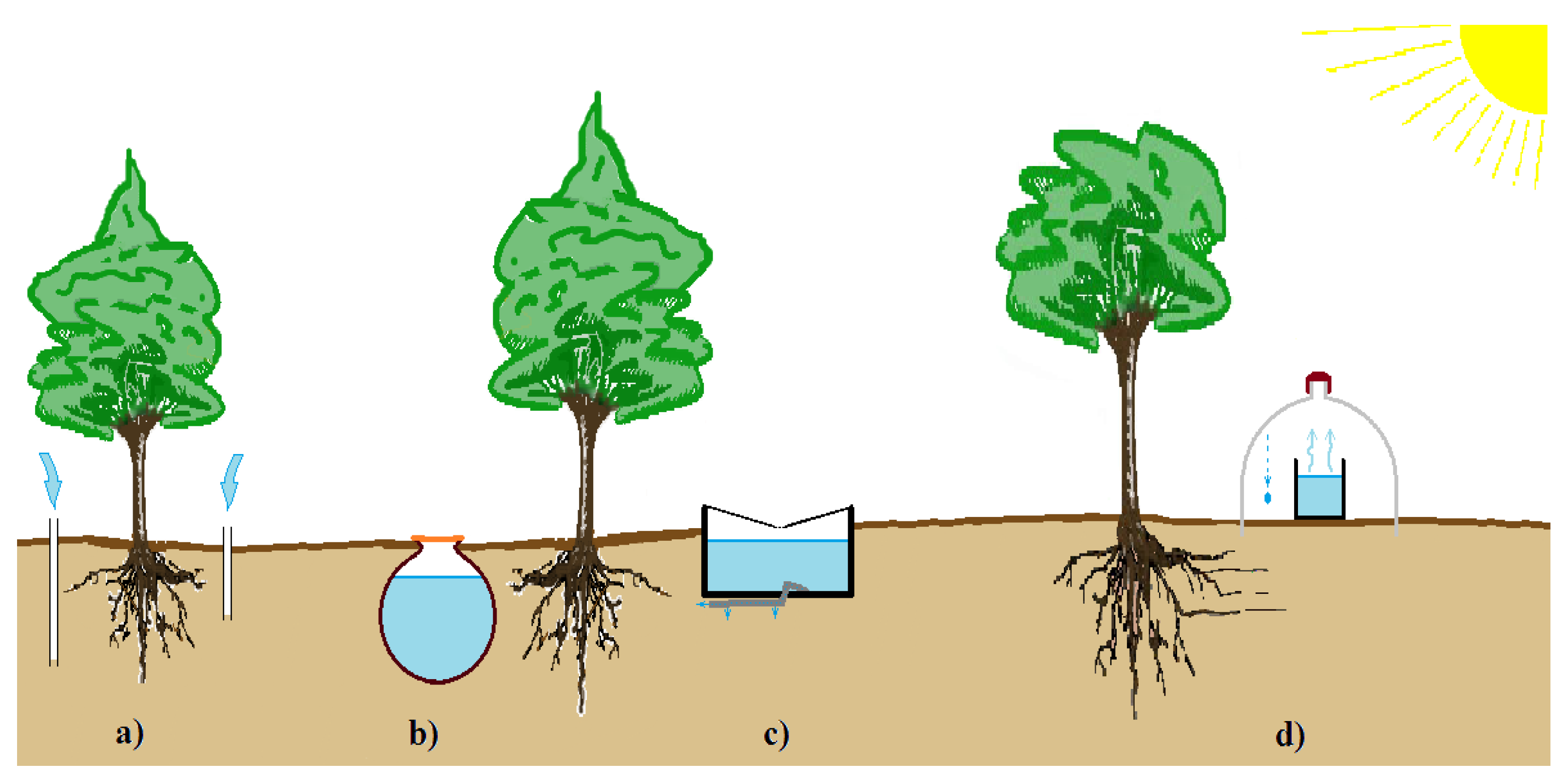
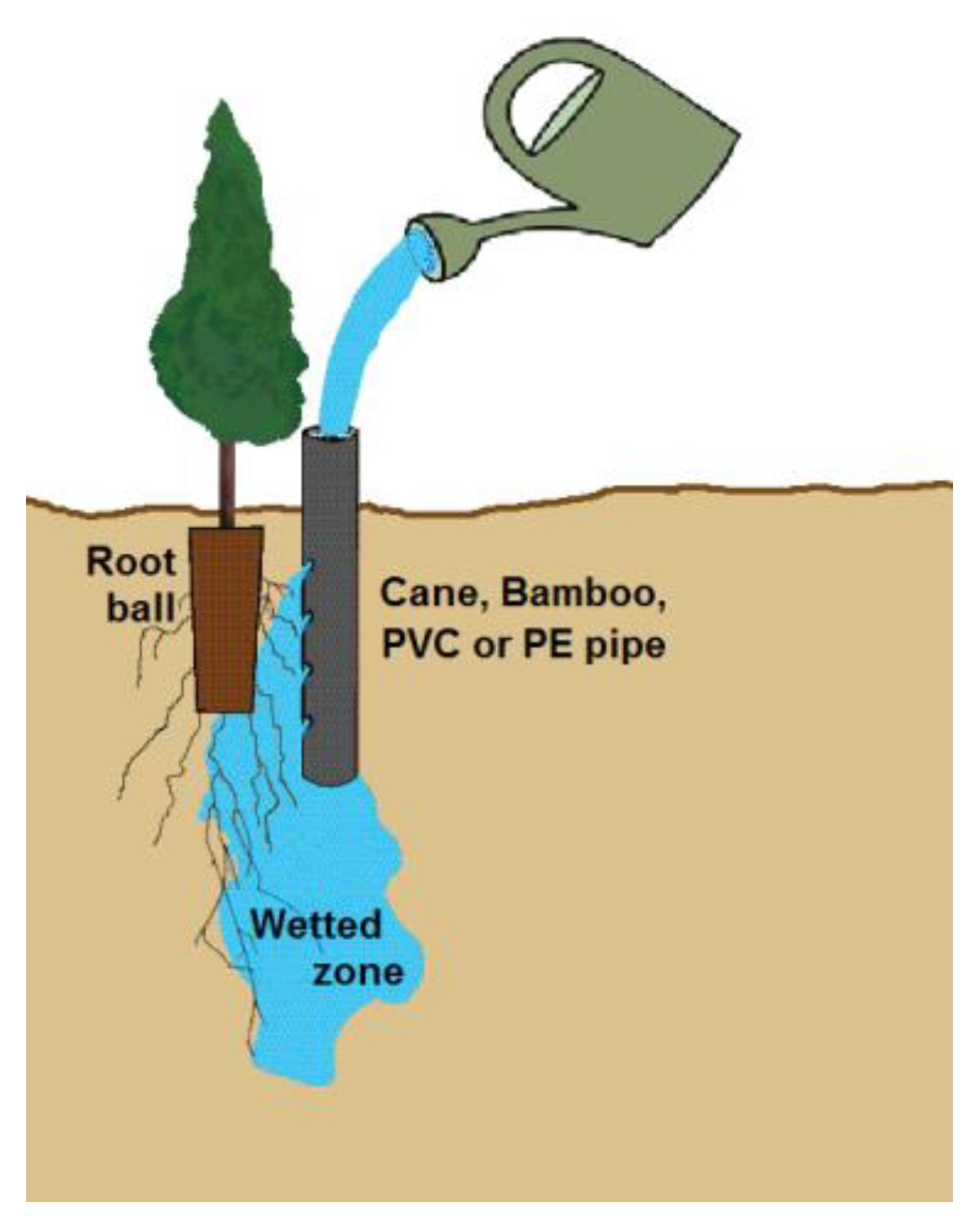


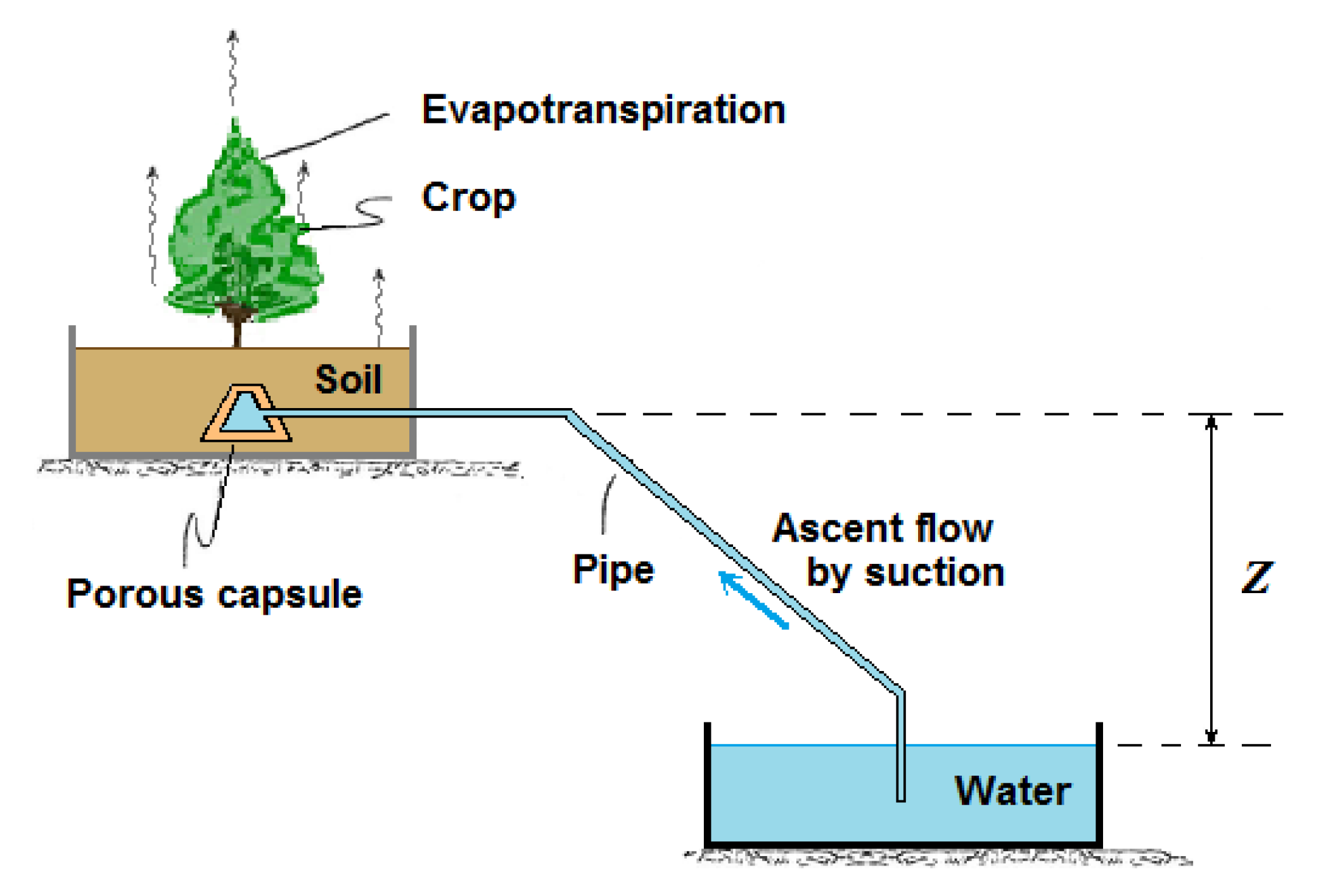
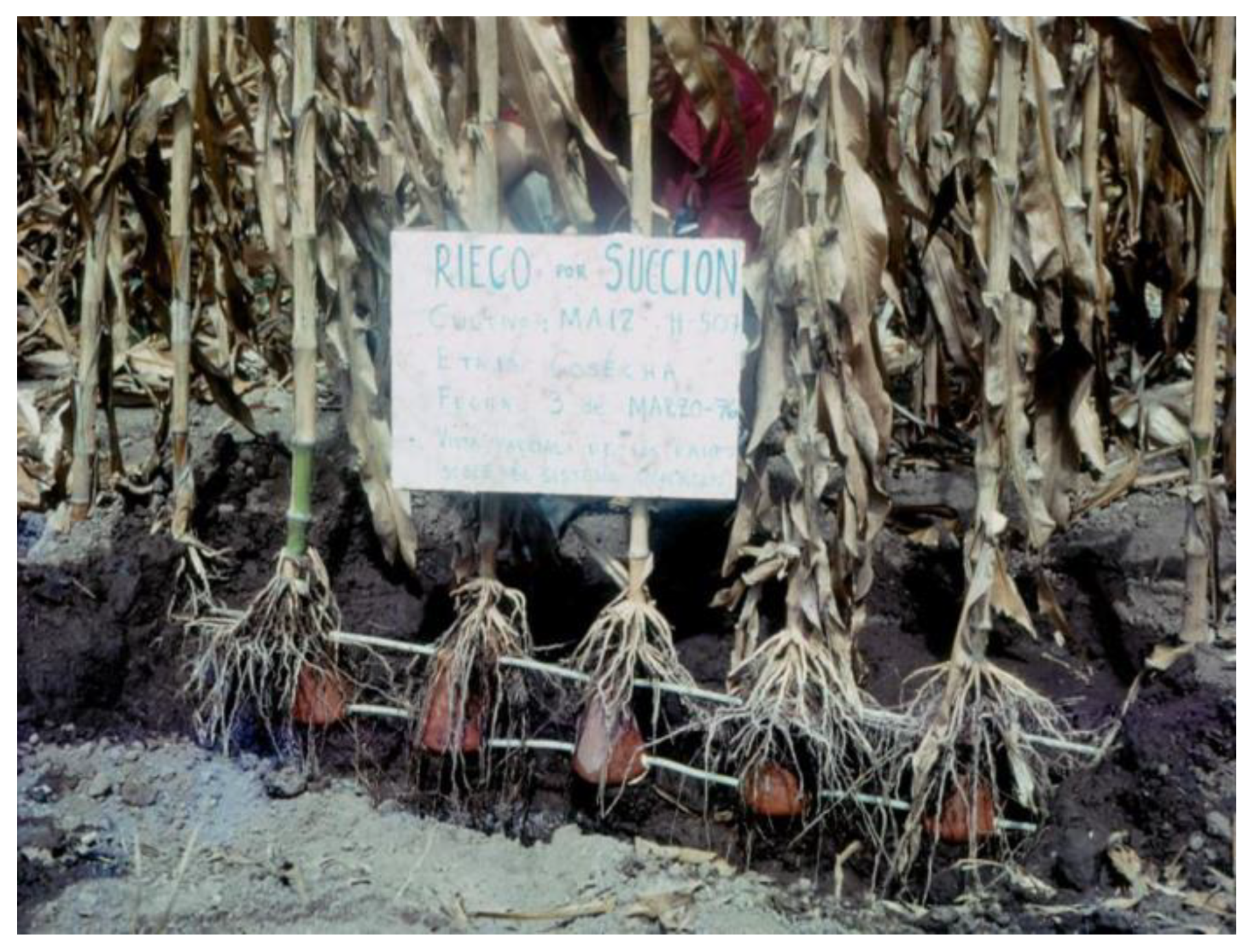
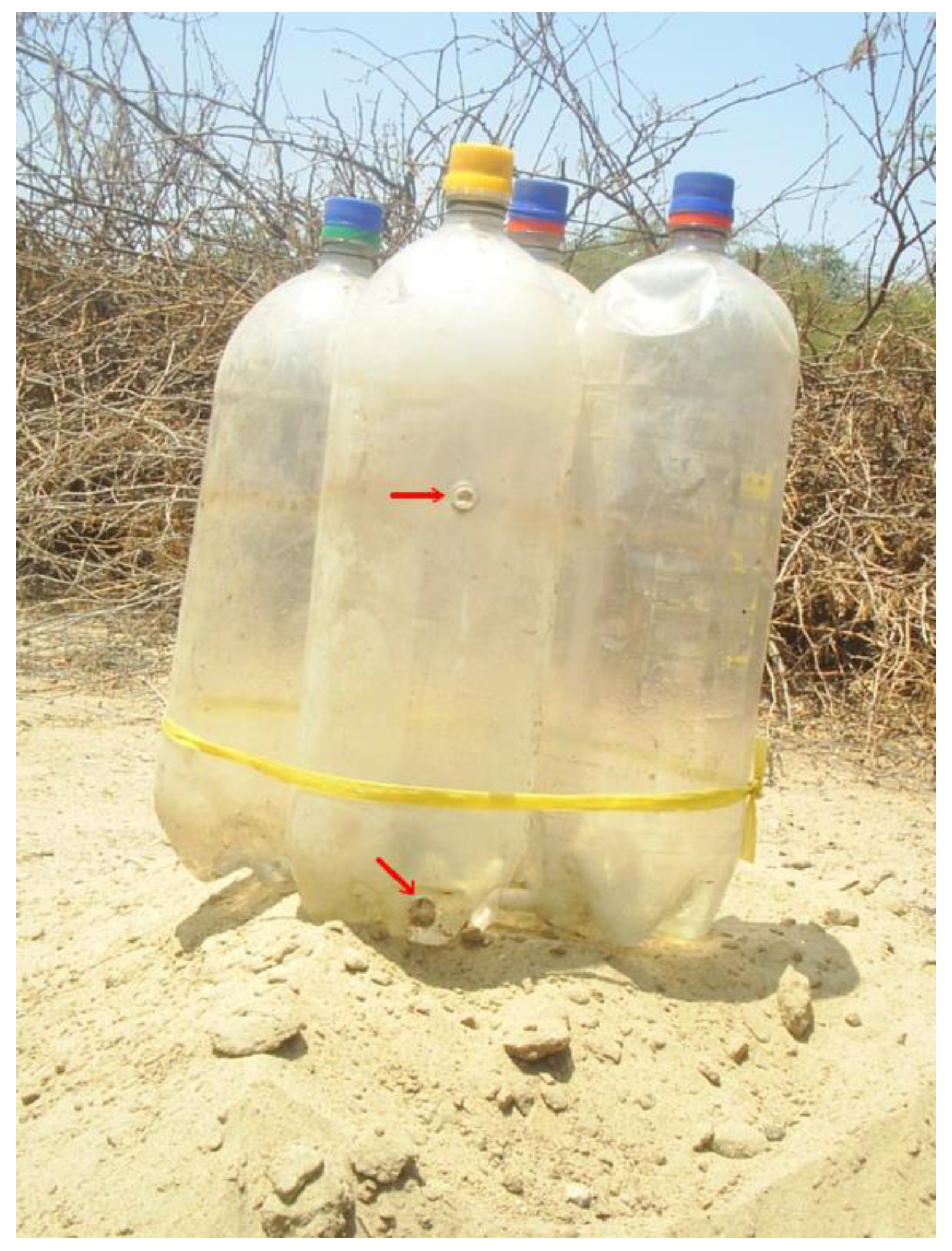
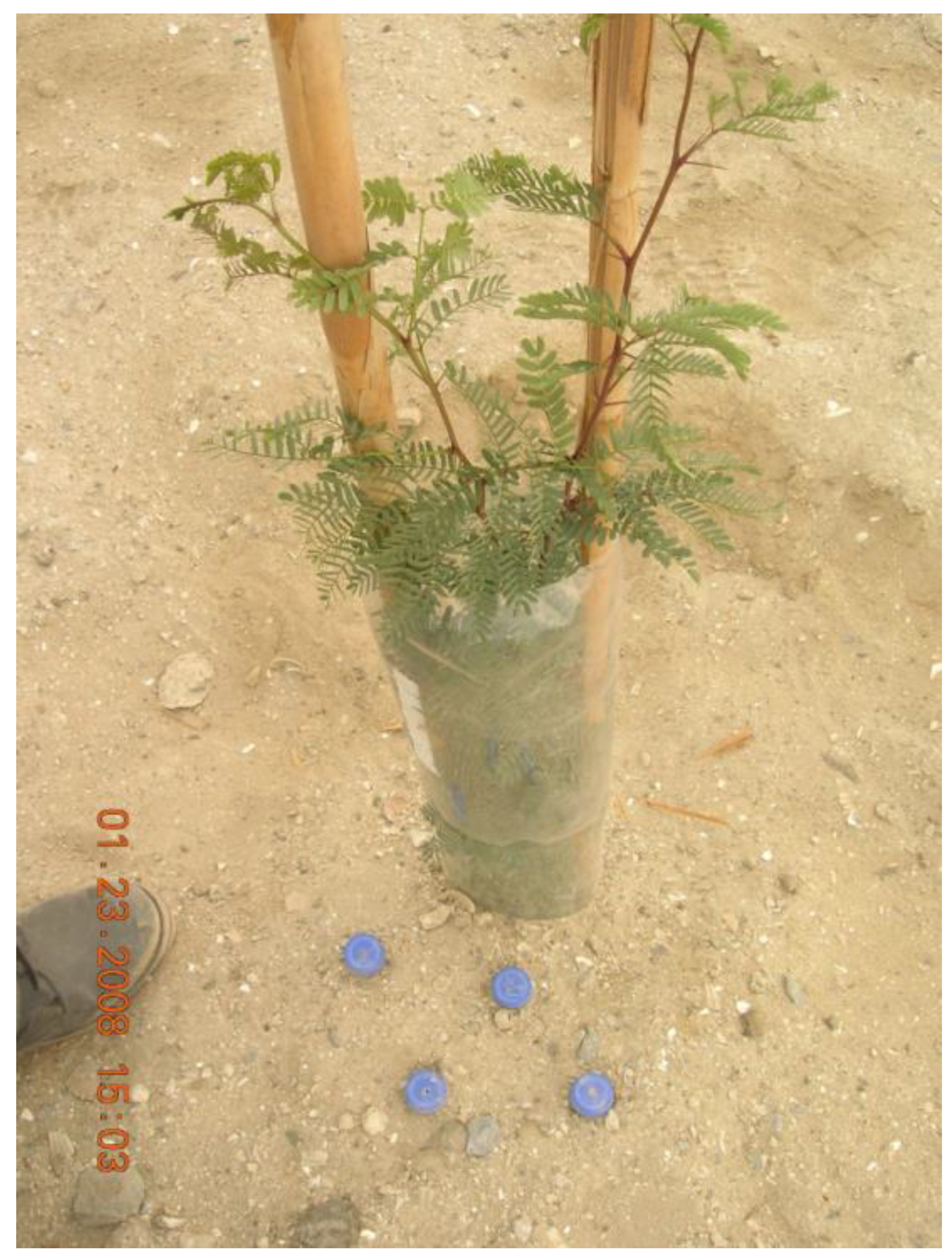

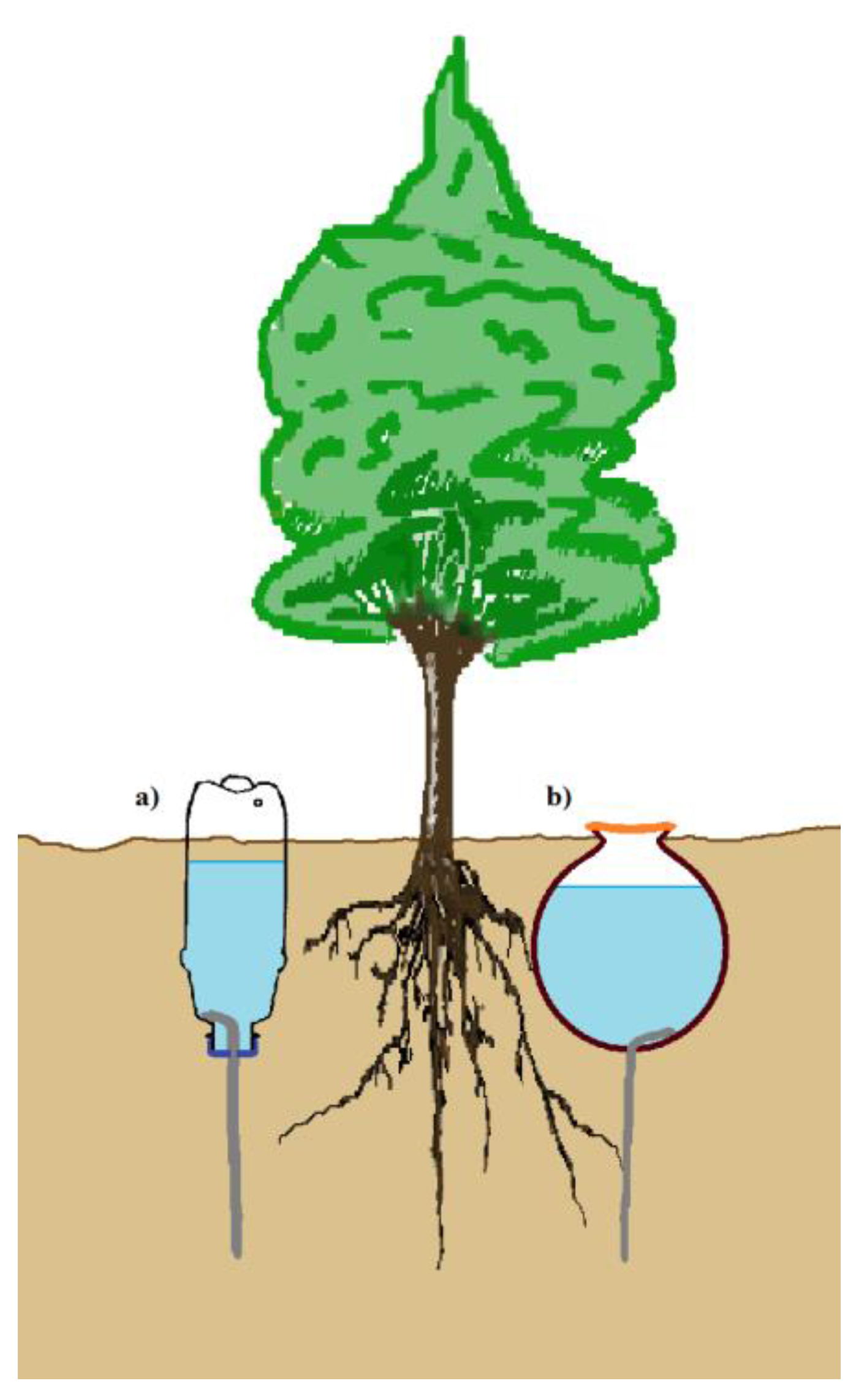

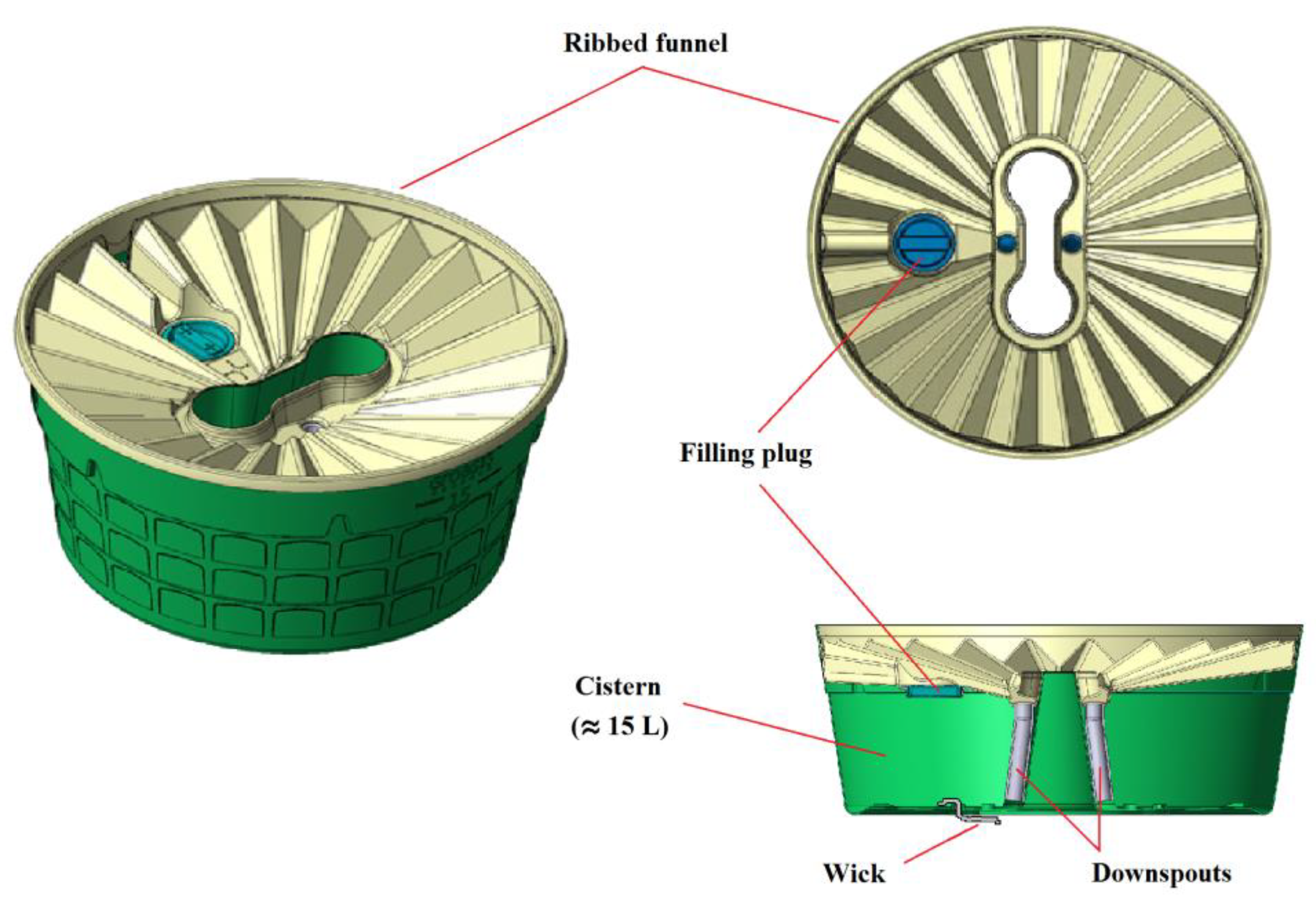
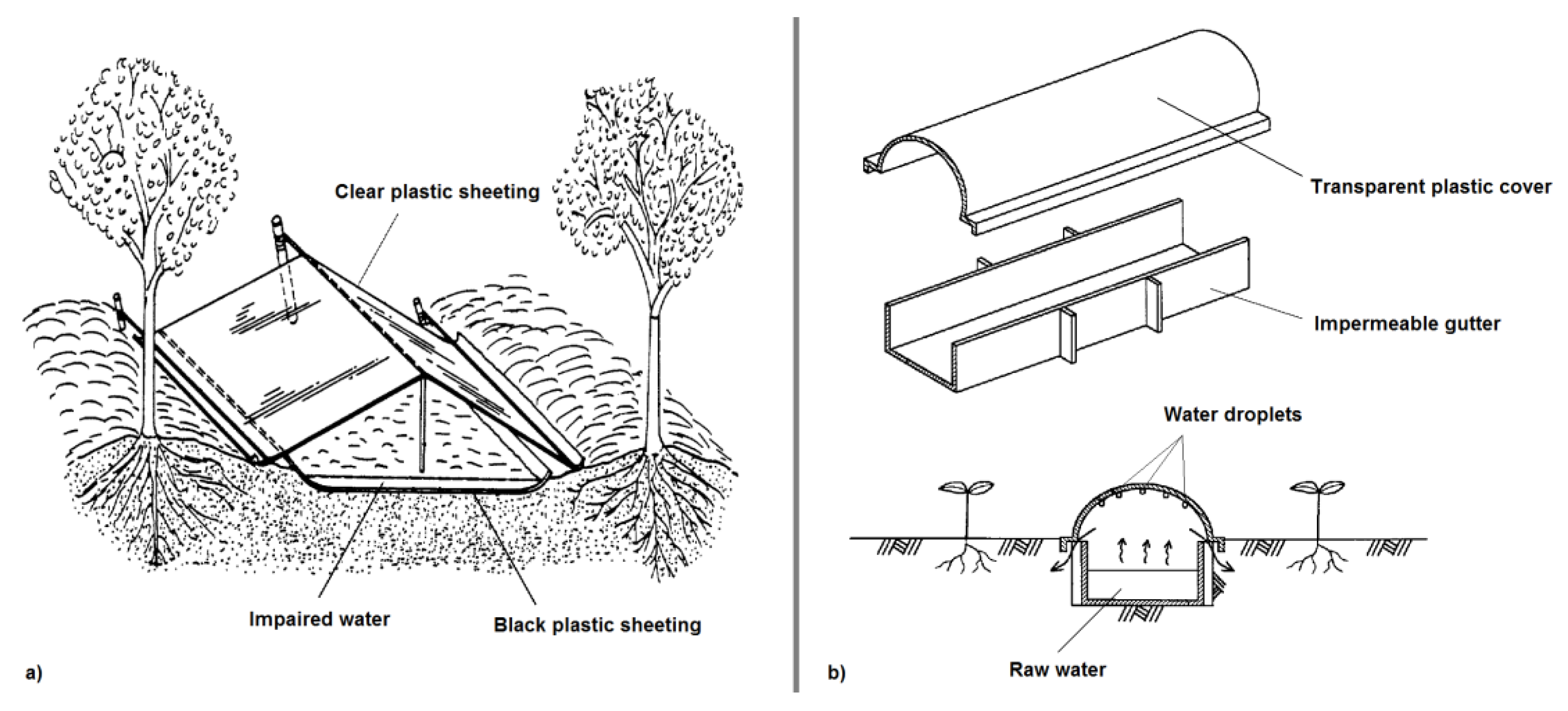
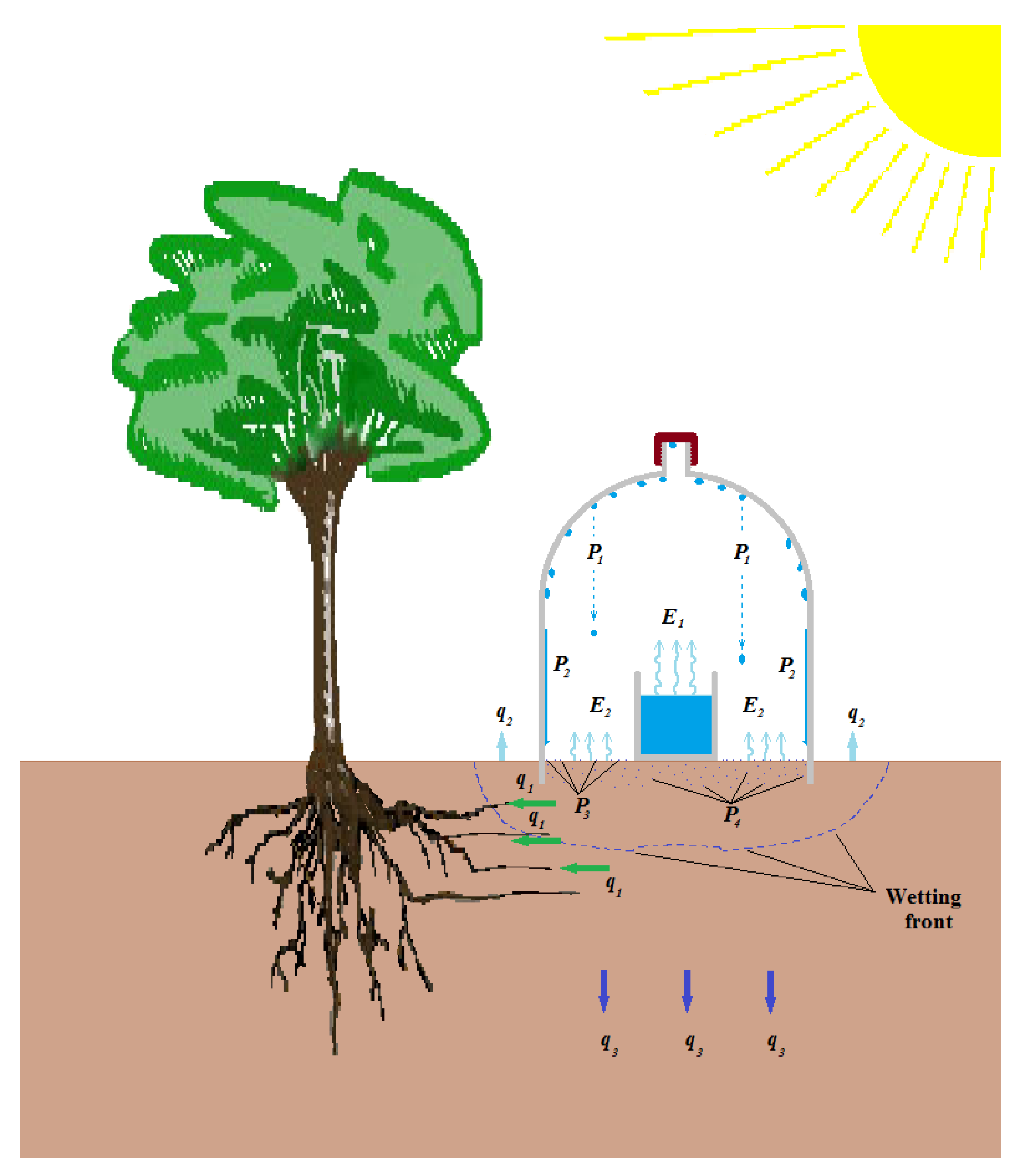
| Irrigation System (Main Reference) | Physical Basis of the Flowrate | Discharge Equation [ |
|---|---|---|
| Sprinkler, microsprinkler, or drip irrigation [23] | Working pressure (h) | (1) |
| Direct deep irrigation [24] | Infiltration (f) | (2) |
| Irrigation through porous walls [25] | Permeability (kso) and water potential (ψ) | (3) |
| Irrigation with felts or wicks [11] | Permeability (ksw), water potential (ψ) and capillarity (I) | (4) |
| Irrigation with solar distillers [26] | Evaporation and condensation | (5) |
| Topic | Advice |
|---|---|
| Site preparation | (1) Deep soil cultivation. (2) Layout water harvesting systems to concentrate surface runoff and infiltration next to the seedlings. (3) Irrigate if both aforementioned measures are not sufficient. |
| Water availability | (1) If scarce: deficit irrigation systems with high water application efficiency; NCISs. (2) If abundant: Deep pipes; tree pit irrigation. |
| Difficult access to afforestation site | (1) Choose an NCIS that needs only one filling during the dry season. (2) Tank and emitter must be designed for this purpose. (3) Very low irrigation frequency, though not necessarily intermittent watering. |
| Performance | (1) To reduce costs, it is advisable to install the NCIS when planting. (2) Results improve with joint irrigation. Approximate figures for individual irrigation: 20 seedlings·h−1; 0.20 ha·workday−1 for a plantation density of 800 seedlings·ha−1). |
| Sandy or shallow soils, with low water retention capacity | Systems with water storage and slow water delivery through porous walls or wicks: pitchers, porous capsules, PET bottles with wicks, Waterboxx®, and similar). |
| Deep loamy, silty, or clayey soils, with good water retention capacity | (1) An inexpensive NCIS can be chosen. (2) Tree pit irrigation and deep pipes are the most inexpensive options. |
| Windbreak | (1) On soils with good water retention capacity, horizontal perforated pipes buried at a depth of 30 to 50 cm are a good option. (2) For sandy soils, other solutions have to be chosen: e.g., porous pipes of baked clay. |
| Water quality | (1) Non filtered, murky, turbid waters: use systems that do not easily clog; avoid wicks, diffusers, fiber filters, drip irrigation emitters. (2) Waters with a high salt content: continuous soil watering (through wicks or porous walls) is preferable to intermittent or sporadic irrigation. (3) Brackish or salty waters: irrigation is only possible using solar distillers: Konkom, Waterfilter Boxx®. |
| * Basic data: (1) Surface (number of seedlings to be irrigated); (2) Quantity and quality of the available water; (3) Cost of the irrigation system; (4) Time needed for single irrigation; (5) Technical means and wages needs; (6) Irrigation dose; (7) Irrigation frequency ; (8) Cost of a single irrigation. | |
| System (Main Reference) | Physical Basis | Cost (EUR·unit−1) | Water Application Efficiency | Maintenance | Usage | Comments |
|---|---|---|---|---|---|---|
| Tree pit irrigation | Infiltration | Very low (0.46) | Low | Low | Individual | Reference irrigation system |
| Deep pipes [11] | Infiltration | Low (0.56) | Medium | Low | Individual | Very easy and efficient system |
| Irrigasc [35] | Infiltration | Medium (1.54) | Medium | Low | Individual | System appropriate for arboriculture |
| Buried diffuser® [34] | Infiltration | Very high (3.91) | High | Medium | Joint | System appropriate for arboriculture |
| Horizontal perforated pipes [11] | Infiltration | Very high (3.74) | Medium | Low | Joint | Good solution for windbreaks |
| Buried stones pocket [32] | Infiltration | Medium (1.65) | Medium | Low | Individual | Appropriate for arboriculture on deep, clayey soils |
| Buried pitchers [41] | Water potential | Medium (1.94) | Very high | Medium | Individual | Traditional “baby bottle” afforestations |
| Porous capsules [37] | Water potential | Medium (1.16) | Very high | Medium | Joint | Good emitters for subsurface drip irrigation |
| RIES bottles [69] | Water potential | Medium (1.58) | Very high | Medium | Individual | Method similar to pitcher irrigation |
| Moistube Microreservoir® [19] | Pressure and water potential | Very high (4.26) | High | Medium | Joint | Appropriate for arboriculture. Requires some working pressure |
| PET bottles with wicks [76] | Water potential and capillarity | Low (0.95) | Very high | Medium | Individual | Easy and efficient artisanal system |
| Pitchers with wicks [77] | Water potential and capillarity | High (2.51) | Very high | Medium | Individual | Combined system |
| Eco Bag® [19] | Water potential and capillarity | Very high (4.11) | Very high | High | Individual | System appropriate for xeriscaping and arboriculture. |
| Waterboxx® [19] | Water potential and capillarity | High (2.75) | Very high | Medium | Individual | The box can be reused up to ten times. |
| Konkom [19] | Solar distillation | Low (0.85) | High | High | Individual | Possibility of using brackish or saltwater. Fragile |
| Waterfilter Boxx® | Solar distillation | High (3.05) | Very high | Medium | Individual | Possibility of using brackish or saltwater. Robust |
| System | Materials | Handmade Production | Installation | Total Cost (Ca ) (EUR·unit-1) |
|---|---|---|---|---|
| Tree pit irrigation | – | – | EUR 0.46 (5 min per pit) | Very low (0.46) |
| Deep pipes | EUR 0.10 (0.5 m PE pipe, 30 mm diameter; used 5 times) | EUR 0.09 (1 min; pipe cutting) | EUR 0.37 (4 min per pipe) | Low (0.56) |
| Irrigasc | EUR 0.10 (plastic bag), EUR 0.49 (rigid cup), 0.12 EUR (6 L of enriched soil) | EUR 0.28 (3 min; bag to cup welding) | EUR 0.55 (6 min per Irrigasc) | Medium (1.54) |
| Buried diffuser® | EUR 3.0 (diffuser), 0.45 EUR (3 m PE pipe, 16 mm diameter) | – | EUR 0.46 (5 min per diffuser) | Very high (3.91) |
| Horizontal perforated pipes | EUR 1.74 (1.00 m drainage PVC pipe, 100 mm diameter) 1 | – | EUR 2.00 (backhoe + 2 workers; EUR 50 ·h−1; pipe buried 50 cm deep; 25 m installed in 1 h) | Very high (3.74) 1 |
| Buried stones pocket | EUR 0.50 (0.5 m PE pipe, 30 mm diameter), EUR 0.05 (1 m2 plastic sheet) | – | EUR 1.10 (1 m trench per seedling, 0.5 m deep; 10 seedlings·h−1; 2 workers) | Medium (1.65) |
| Buried pitchers | EUR 1.48 (2 L clay pot) | – | EUR 0.46 (5 min per pitcher) | Medium (1.94) |
| Porous capsules | EUR 0.70 (0.5 L capsule), EUR 0.09 (3 m PE pipe, 16 mm diameter; used 5 times) | – | EUR 0.37 (4 min per capsule) | Medium (1.16) |
| RIES bottles | EUR 0.04 (4 reused PET bottles), EUR 0.04 (material for 4 fiber filters), EUR 0.03 (3 mini tubings) | EUR 0.92 (10 min; heat sealing of filters and tubings to the bottles) | EUR 0.55 (6 min per RIES) | Medium (1.58) |
| Moistube Microreservoir® | EUR 0.48 (1 reservoir), EUR 0.45 (3 m PE pipe, 16 mm diameter) | – | EUR 3.33 (backhoe + 2 workers installing bottles and pipes buried 30 cm; EUR 50·h−1; 45 m installed in 1 h) | Very high (4.26) |
| PET bottles with wicks | EUR 0.01 (1 reused PET bottle), EUR 0.20 (0.4 m nylon wick, 8 mm diameter) | EUR 0.37 (4 min; drill, knot, and threading, bottle cap closing) | EUR 0.37 (4 min per bottle) | Low (0.95) |
| Pitchers with wicks | EUR 1.48 (2 L clay pot), EUR 0.20 (0.4 m nylon wick, 8 mm diameter) | EUR 0.28 (3 min; knot and threading) | EUR 0.55 (6 min per pitcher) | High (2.51) |
| Eco Bag® | EUR 3.74 (used 2 times) | – | EUR 0.37 (4 min per bag) | Very high (4.11) |
| Waterboxx® | EUR 2.20 (used 5 times) | – | EUR 0.55 (6 min per box) | High (2.75) |
| Konkom | EUR 0.02 (2 reused PET bottles) | EUR 0,28 (3 min to trim the bottles) | EUR 0.55 (6 min per Konkom) | Low (0,85) |
| Waterfilter Boxx® | EUR 2.50 (used 5 times) | – | EUR 0.55 (6 min per box) | High (3.05) |
Remarks:
| ||||
Publisher’s Note: MDPI stays neutral with regard to jurisdictional claims in published maps and institutional affiliations. |
© 2022 by the authors. Licensee MDPI, Basel, Switzerland. This article is an open access article distributed under the terms and conditions of the Creative Commons Attribution (CC BY) license (https://creativecommons.org/licenses/by/4.0/).
Share and Cite
Martínez de Azagra Paredes, A.; Del Río San José, J.; Reque Kilchenmann, J.; Diez Hernández, J.M.; Sanz Ronda, F.J. Methods for Watering Seedlings in Arid Zones. Forests 2022, 13, 351. https://doi.org/10.3390/f13020351
Martínez de Azagra Paredes A, Del Río San José J, Reque Kilchenmann J, Diez Hernández JM, Sanz Ronda FJ. Methods for Watering Seedlings in Arid Zones. Forests. 2022; 13(2):351. https://doi.org/10.3390/f13020351
Chicago/Turabian StyleMartínez de Azagra Paredes, Andrés, Jorge Del Río San José, José Reque Kilchenmann, Juan Manuel Diez Hernández, and Francisco Javier Sanz Ronda. 2022. "Methods for Watering Seedlings in Arid Zones" Forests 13, no. 2: 351. https://doi.org/10.3390/f13020351
APA StyleMartínez de Azagra Paredes, A., Del Río San José, J., Reque Kilchenmann, J., Diez Hernández, J. M., & Sanz Ronda, F. J. (2022). Methods for Watering Seedlings in Arid Zones. Forests, 13(2), 351. https://doi.org/10.3390/f13020351







